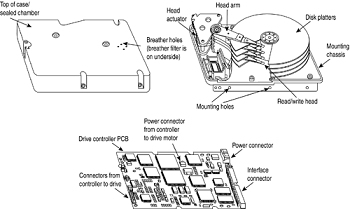Hard Disk Drive Component
Many types of hard disk drives are on the market, but nearly all share the same basic physical components. Some differences might exist in the implementation of these components (and in the quality of the materials used to make them), but the operational characteristics of most drives are similar.
The basic components of a typical hard disk drive are as follows:

-
Read/write heads
-
Head actuator mechanism
-
Spindle motor (inside platter hub)
-
Logic board (controller or Printed Circuit Board)
-
Cables and connectors
-
Configuration items (such as jumpers or switches)
The platters, spindle motor, heads, and head actuator mechanisms usually are contained in a sealed chamber called the head disk assembly (HDA).
The HDA is usually treated as a single component; it is rarely opened. Other parts external to the drive's HDA, such as the logic boards, bezel, and other configuration or mounting hardware, can be disassembled from the drive.
Hard Disk Platters (Disks)
A hard disk drive has one or more platters, or disks. Hard disks for PC systems have been available in several form factors over the years. Normally, the physical size of a drive is expressed as the size of the platters. Following are the platter sizes that have been associated with PC hard disk drives:
-
5 1/4'' (actually 130mm, or 5.12'')
-
3 1/2'' (actually 95mm, or 3.74'')
-
2 1/2'' (actually 65mm, or 2.56'')
-
1.8'' (actually 48mm, or 1.89'')
-
1'' (actually 34mm, or 1.33'')
Larger hard disk drives that have 8'', 14'', or even larger platters are available, but these drives are not used with PC systems. Currently, the 3 1/2'' drives are the most popular for desktop and some portable systems, whereas the 2 1/2'' and smaller drives are very popular in portable or notebook systems.
During 1998, IBM introduced a drive called the MicroDrive (now manufactured by Hitachi Global Storage Technologies), which currently can store up to 4GB or more on a single platter about the size of a quarter!
These drives are in the physical and electrical format of a Type II Compact Flash (CF) card, which means they can be used in any device that takes CF cards, including digital cameras, personal digital assistants (PDAs), MP3 players, and anywhere else Compact Flash memory cards can be used.
Several companies have introduced 1.8'' drives over the years, most notably HP, Calluna, and Toshiba. Of those, only Toshiba continues to manufacture drives in that format.
In 2000, Toshiba introduced its 1.8'' drives, which are available in the physical format of a Type II PC Card. These drives are available in capacities of up to 5GB or more and can be used in laptop or notebook computers or anywhere a standard PC Card can be plugged in.
Most hard disk drives have two or more platters, although some of the smaller drives used in portable systems and some entry-level drives for desktop computers have only one.
The number of platters a drive can have is limited by the drive's vertical physical size. The maximum number of platters I have seen in any 3 1/2'' drive is 12; however, most drives have 6 or fewer.
Platters have traditionally been made from an aluminum/magnesium alloy, which provides both strength and light weight. However, manufacturers' desire for higher and higher densities and smaller drives has led to the use of platters made of glass (or, more technically, a glass-ceramic composite).
One such material, produced by the Dow Corning Corporation, is called MemCor. MemCor is composed of glass with ceramic implants, enabling it to resist cracking better than pure glass. Glass platters offer greater rigidity than metal (because metal can be bent and glass can't) and can therefore be machined to one-half the thickness of conventional aluminum disks—sometimes less.
Glass platters are also much more thermally stable than aluminum platters, which means they do not expand or contract very much with changes in temperature.
Several hard disk drives made by companies such as IBM, Seagate, Toshiba, Areal Technology, and Maxtor currently use glass or glass-ceramic platters; in fact, Hitachi Global Storage Technologies (Hitachi and IBM's joint hard disk venture) is designing all its new drives with only glass platters.
For most other manufacturers as well, glass disks will probably replace the standard aluminum/magnesium substrate over the next few years.